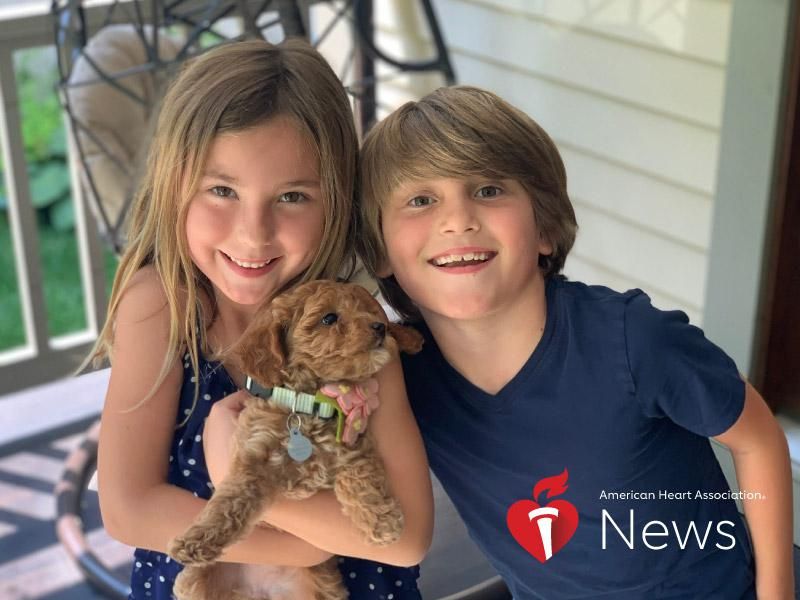TUESDAY, Jan. 19, 2021 (American Heart Association News) — The wind howled and thunder boomed as an ambulance raced Spencer Timmel and his newborn son, Charlie, to a hospital better able to care for infants with heart problems.
“The weather was very reflective of what was going on in our lives,” Spencer said. “The perfect storm.”
Spencer and his wife, Erin, had tried for years to conceive before she became pregnant with Charlie. Nine drama-free months later, doctors delivered Charlie. Then, like the weather outside, “Things started to spiral out of control,” Spencer said.
Ordinarily, a newborn baby’s skin turns pink shortly after birth, as the heart pumps oxygen-rich blood throughout the body. Charlie’s skin, however, had a blueish tint – a sign that something was wrong with his heart. Realizing the boy needed advanced care, doctors sent him to a nearby children’s hospital in Cincinnati.
Before they left, nurses wheeled Charlie into Erin’s room, where she was still recovering from childbirth. While she didn’t know the specifics, the new mother understood something was wrong with Charlie’s heart.
“I couldn’t hold him,” she said, fighting back tears. “I thought I was going to lose my baby.”
Despite the stormy weather, the ambulance arrived safely at Cincinnati Children’s Hospital. There, doctors discovered the two main arteries leaving Charlie’s heart were reversed – a condition called transposition of the great arteries. This caused deoxygenated blood to bypass the lungs, starving the rest of his body of oxygen.
The permanent solution is an operation in which surgeons reconnect the arteries the correct way.
“It allows most children to have essentially normal cardiac function, exercise capacity and the ability to run and play the same way as their classmates,” said Dr. James Cnota, the director of fetal cardiology at Cincinnati Children’s Hospital and one of the on-call doctors the night Charlie was admitted. “There’s some risk upfront, but the longer-term outlooks look very good.”
Meanwhile, just 36 hours after a cesarean section, Erin requested to be discharged. Doctors relented and she arrived to see Charlie swollen and unable to cry because of the breathing tube in his throat.
“He looked so tiny next to all the machines,” she recalled.
During the operation, doctors gave hourly updates to Erin, Spencer and their family. Finally, after six hours, Charlie was out of surgery. It was a success. When they finally took the tube out of his throat, he cried for the first time since he was born.
“We all cried in relief,” Erin said. “You can’t imagine how emotional it was.”
Since Charlie had been on a feeding tube since he was born, doctors feared he might not know how to eat, so they sent him home with it. Two days later, Charlie accidentally pulled out the tube. Spencer and Erin decided to give him a bottle and see how it went. He drank it down with no problems.
“We got lucky there,” Spencer said. “Finally, after a few weeks, a kid with no tubes anywhere in his body.”
Now 8, Charlie is doing well in school. He enjoys playing sports and being a big brother to Ella, who arrived a year later.
“He’s about the happiest kid with the best attitude around, which is pretty cool,” Spencer said.
Other than a checkup every two years, his life is a lot like most kids his age.
Eager to help other children like Charlie, the family teamed up with Cincinnati Children’s Hospital, the Congenital Heart Alliance of Cincinnati and the nonprofit The First Tee to start SCRATCHgolf. The program has introduced nearly 100 kids with heart disease to the game and is expanding to children’s hospitals across the country.
“Our mission is to help heart kids improve socially, mentally and physically through golf,” Spencer said. “The name has a dual meaning. A premier golfer is considered ‘scratch’ and many of the heart kids have visible scars or ‘scratches’ from their heart surgeries.”
The family also became involved with the American Heart Association. Their story was featured at the 2019 Cincinnati Heart Ball, where Charlie wore a tuxedo with Lego cufflinks and a red bow tie.
Charlie and his dad addressed the 1,100 attendees.
“I was kinda nervous because I don’t like being on a stage in front of a lot of people, but it helped that my dad was there,” Charlie said. “I think it’s important to tell my story, because people might not know what to do, and I want to help other people understand.”
Copyright © 2025 HealthDay. All rights reserved.

